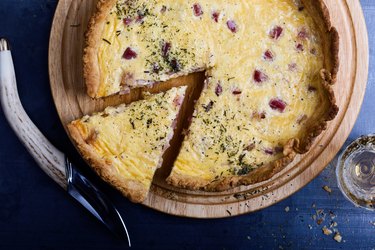
Quiche is a savory egg custard baked into a decadent pastry crust — but making one isn't quite as simple as popping it all in the oven. You must bake the empty quiche crust first — a process known as blind baking — then add the filling and bake again.
Tip
Yes, you should cook a quiche crust before adding the filling. This technique, called "blind baking," keeps the moist filling from turning the crust soggy as it cooks.
Video of the Day
Blind Baking a Quiche Crust
Blind baking isn't reserved exclusively for quiche: You also use this process for any sort of tart or pie that has a very wet filling that would turn an unbaked crust soggy as it cooks, or for cream pies and other varieties where the crust needs to be cooked in the oven but the filling should not be.
Video of the Day
Le Cordon Bleu's expert chefs demonstrate the proper technique for blind baking a pastry crust: Once you've rolled out the crust and pressed it firmly into the tart/pie pan, chill it for about 15 minutes, trim off extra crust dough, then line the crust with ovenproof cling film, parchment paper or foil.
Preheat the oven to 350 to 375 degrees Fahrenheit. Fill the crust with uncooked rice, dried beans or pie weights (small metal or ceramic balls made specifically for blind baking), then slide it into the oven and bake until the edges are golden brown.
The weights keep the crust from puffing up or shrinking as it bakes. Once the crust is done, you can remove the weights, add the filling and then return your quiche to the oven for the remainder of its cook time.
Read more: 9 Things You May Not Know About Eggs
Quiche Recipe Ideas and Tips
Even if you're using an unconventional crust, like the gluten-free crust in this LIVESTRONG.com Cauliflower Crust Quiche recipe, you'll still bake the crust first. The only exception is a crustless quiche. For example, if you make this delicious quiche in portabella caps, you won't bake the mushroom caps first. Instead, the entire dish goes in the oven at once.
No matter which type of quiche you're making, place the solid filling items — like bacon crumbles or vegetables — in the bottom first, then add your egg custard filling on top.
How can you be sure your quiche is done? Common wisdom includes checking for a browned top, a fully set filling, or placing a toothpick in the middle to see if it comes out cleanly. But according to FoodSafety.gov, in order to avoid foodborne illnesses such as salmonella, you should use a food thermometer to make sure the center of the quiche is heated to a minimum of 160 F.
Read more: A Substitute for Heavy Cream in Quiche
Tip
Got leftovers? FoodSafety.gov says your cooked quiche will keep for three to five days in the refrigerator, or for two to three months in the freezer.
Food Safety in Egg Dishes
If you haven't been using a food thermometer for your quiche, the authors of a September 2016 issue of the journal Foods offer some hope. They analyzed 226 different egg dish recipes from cookbook, magazine and website sources, and noted that although very few of them noted internal temperature as a way of measuring doneness, most of the recipes still produced food-safe products that exceeded the recommended internal temperature.
However, there were a few recipes that didn't exceed that temperature — and every oven and recipe work differently. And as the U.S. National Library of Medicine notes, although most people recover from salmonella infections in about a week without treatment, it can be worse in older adults, infants and people with chronic health problems — and if the salmonella infection reaches your bloodstream, you could be in serious trouble.
Bottom line: It's well worth making a modest investment in a food thermometer to avoid a "one in a million" case of food poisoning that could cause problems for you or your loved ones.
- ChooseMyPlate.gov: "Herbed Spinach Quiche Portabella Caps"
- FoodSafety.gov: "Safe Minimum Cooking Temperatures Charts"
- Foods: "Food Safety: Recommendations for Determining Doneness in Consumer Egg Dish Recipes and Measurement of Endpoint Temperatures When Recipes Are Followed"
- U.S. National Library of Medicine: "Salmonella Infections"
- FoodSafety.gov: "Cold Food Storage Chart"
- Le Cordon Bleu: "French French Pâtisserie Technique: Lining a Tart Pan and Blind Baking"